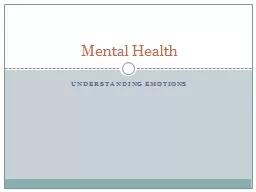

Personality Nature Vs Nurture What has the greatest influence Nature traits your born with Nurture Environment your raised in Heredity Environment Family Modeling Friends Peer Group ID: 775227
Download Presentation The PPT/PDF document " Understanding Emotions Mental Health" is the property of its rightful owner. Permission is granted to download and print the materials on this web site for personal, non-commercial use only, and to display it on your personal computer provided you do not modify the materials and that you retain all copyright notices contained in the materials. By downloading content from our website, you accept the terms of this agreement.
Slide1
Understanding Emotions
Mental Health
Slide2Personality
Nature Vs Nurture
What has the greatest influence?
Nature – traits your born with
Nurture – Environment your raised in
Heredity
Environment
Family
Modeling
Friends
Peer Group
Culture
Slide3Stages of Personality Development
Develop trust – birth -18 months
Learn to be independent – 18m – 3 years
Take initiative – 3 -6yrs
Develop Skills – 6-12 yrs
Search for Identity – 12 – 20 yrs
Identity –sense if self
Establish Intimacy – 20 -40yrs
Create & Nurture – 40 -65 yrs
Look back w/Acceptance – 65 +
Slide4Self Esteem
The confidence and worth that you feel about yourself– is directly related to your general level of wellness
How is Self Esteem Formed?
Feed-back
Messages from others that indicate who they think you are or what they think you are like.
Self- Talk
Positive self-talk
Negative Self Talk
Slide5Esteem Continued
Benefits of high Self esteem
What are they?
Risks of Low Self Esteem
What are they?
How Self- Esteem Develops
Childhood
Adolescence
Adulthood
Slide6Improving your self esteem
Make a list of strengths and weakness
Set ambitious, but realistic goals
Don’t be to hard on yourself
Rely on your values
Learn to accept accomplishments
Looks beyond your own concerns
Do not focus too much on appearance.
Slide7Emotions
What Are Our
E
motions?
Signals that tell your mind and boy how to react.
What are some of our most common emotions?
What are some of the changes you body may go through when feeling certain emotions?
Give an example of a scenario and the emotion that relates
Love, Empathy, Fear, Anger, & Guilt
Slide8Slide9Phobias
Phobia is and Irrational Fear that we have.
What are some of your Phobias?
Slide10Common Phobias
HematophobiaFear of blood
Slide11Ailurophobia
Fear of Cats
Slide12Demophobia
Fear of Crowds
Slide13Nyctophobia
Fear of the Dark
Slide14Belonephobia
Fear of needles
Slide15Ophidiophobia
Slide16arachnophobia
Slide17Reacting to our Emotions
Defense Mechanisms
What are Defense Mechanisms?Strategies used to deal with strong or stressful emotions and situations.How do we develop our defense mechanisms?What are some of the common Defense Mechanisms?
Slide18Common Defense Mechanisms
Repression
Suppression
Rationalization
Regression
Denial
Compensation
Projection
Idealization
Slide19Activity
As a group (Table or Row) you will be given a defense mechanism or two. It is up to the group to discuss and rationalize an example of your given defense mechanism.
Page 204 in your book will help you define your defense mechanisms so you can develop your example.